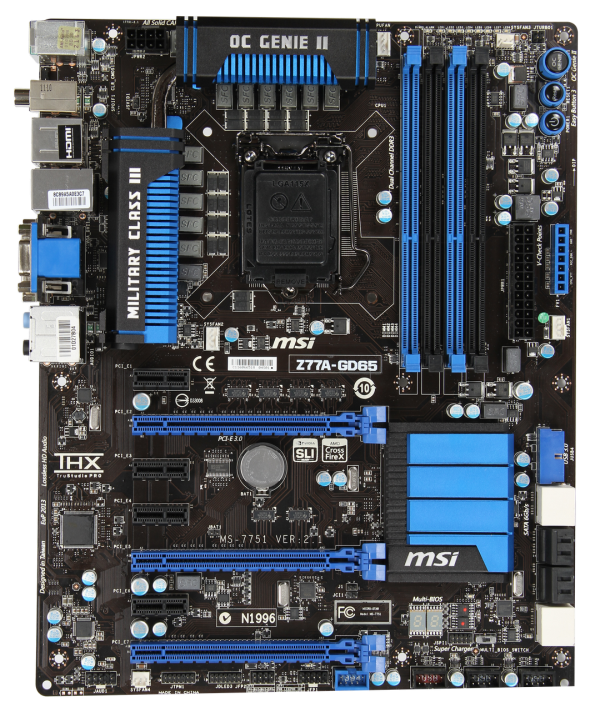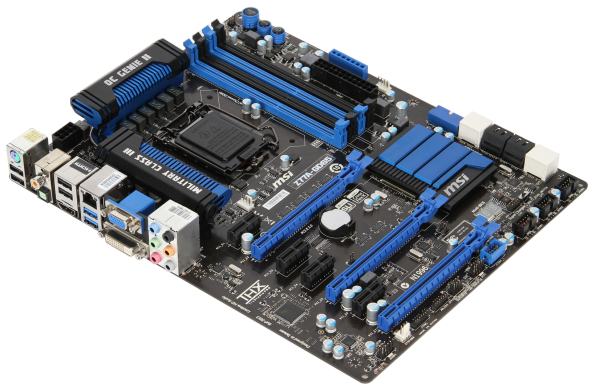Intel Z77 Panther Point Chipset and Motherboard Preview – ASRock, ASUS, Gigabyte, MSI, ECS and Biostar
by Ian Cutress on April 8, 2012 12:00 AM EST- Posted in
- Motherboards
- Intel
- Biostar
- MSI
- Gigabyte
- ASRock
- Asus
- Ivy Bridge
- ECS
- Z77
MSI Z77A-GD65—Visual Inspection
Whenever it comes to a motherboard comparison involving ASUS, Gigabyte or ASRock against an MSI board, the MSI board always tends to show a strong result—either in terms of price, performance or features. So when it comes to the new batch of motherboards for Ivy Bridge, it is fair to say that I expect a strong showing from MSI. For this preview, we have their Z77A-GD65, which will be one behind their future released GD80 that got attention back at CES for being Thunderbolt equipped.
The Z77A-GD65 is another motherboard in this roundup that comes in a black and blue livery. This time MSI have more of an excuse than others do as they have been using it for a fair while now. Using what is essentially a 10 + 2 phase power delivery, MSI are using somewhat beefier heatsinks than their rivals, connecting both via a heatpipe. The socket area is right up against Intel's minimum requirements from left to right, but there is some room to maneuver big air coolers from top to bottom. Around the socket there are at least four fan headers to use: one 4-pin CPU header between the top VRM and the memory slots, a 4-pin system fan header just the other side of the memory slots, a 4-pin to the bottom left of the socket area, and another 4-pin beside the 24-pin ATX power connector. A fifth fan header can be found at the bottom of the board.
Along the right hand side, we have the standard MSI trio of power/reset/OC Genie buttons, followed but a series of voltage checkpoints for overclockers. Aside from the 24-pin power connector and the system fan header, there is also a USB 3.0 header at right angles to the board, indicating its primary use is to the front of the case. Underneath this are the eight SATA ports—two SATA 6 Gbps from the PCH, four SATA 3 Gbps also from the PCH, and another two SATA 6 Gbps from an ASMedia controller.
As the power/reset/OC Genie buttons are at the top right, the bottom of the board has more room to fit in all the headers as needed—front panel audio, TPM, front panel headers and USB 2.0 headers. In terms of PCIe, MSI have done away with the PCIe to PCI bridge and focused purely on PCIe. We have an x1, x16 (x8 with dual GPU), x1, x1, x8, x1, and a PCIe 2.0 x4. In this instance, there is plenty of room for a dual GPU setup with PCIe slots to spare for any extras.
Also of note is the chipset cooler, which is very flat and large with minimal fins, perhaps suggesting that MSI is confident about their heatsink design. Underneath this is a two digit debug display, and a BIOS switch for changing between two BIOSes.
On the rear IO panel, I think MSI have been reasonable with what they have left in and what they have left out. From left to right, we have a combination PS/2 port, two USB 2.0 ports (black), a clear CMOS button, digital and coaxial SPDIF outputs, two more USB 2.0 ports (black), a HDMI port, gigabit Ethernet, two USB 3.0 ports (blue), D-Sub, DVI-D, and audio jacks.
Board Features
| MSI Z77A-GD65 | |
| Size | ATX |
| CPU Interface | LGA-1155 |
| Chipset | Intel Z77 |
| Power Delivery (CPU/iGPU) | 8 + 1 + 2 + 1 (VRM/VTT/GPU/SA) |
| Memory Slots |
Four DDR3 DIMM slots supporting up to 32 GB Up to Dual Channel, 1066-2667 MHz |
| Video Outputs | HDMI, DVI-D, D-Sub |
| Onboard LAN | Intel 82579V |
| Onboard Audio | Realtek ALC898 |
| Expansion Slots |
2 x PCIe x16 Gen3 (x16, x8/8) 1 x PCIe x16 Gen2 (x4) 4 x PCIe x1 Gen2 |
| Onboard SATA/RAID |
2 x SATA 6 Gbps (PCH), Support for RAID 0, 1, 5, 10 4 x SATA 3 Gbps (PCH), Support for RAID 0, 1, 5, 10 2 x SATA 6 Gbps (ASMedia ASM1061) |
| USB |
4 USB 3.0 ports (2 back panel, 2 from headers) 10 USB 2.0 ports (4 back panel, 6 from headers) |
| Onboard |
4 x SATA 6Gbps 4 x SATA 3 Gbps 1 x USB 3.0 Header 3 x USB 2.0 Headers 1 x IEEE1394 Header 1 x TPM Header 1 x Front Panel Audio Header Power/Reset Buttons OC Genie 5 x Fan Headers |
| Power Connectors |
1 x 24-pin ATX connector 1 x 8-pin 12V connector |
| Fan Headers |
1 x CPU Fan Header (4-pin) 4 x SYS Fan Headers (two 4-pin, two 3-pin) |
| IO Panel |
1 x Combo PS/2 Port 1 x Clear CMOS Button 1 x Coaxial S/PDIF Port 1 x Optical S/PDIF Port 4 x USB 2.0 2 x USB 3.0 1 x Gigabit Ethernet Audio Jacks 1 x HDMI 1 x DVI-D 1 x D-Sub |
| Warranty Period | 3 Years |
| Product Page | Link |
It is good to see an Intel NIC on this $180 MSRP motherboard. There are plenty of headers to go around. The only things missing where other motherboards may have better all-round functionality are a PCI slot, mSATA and on-board WiFi.













145 Comments
View All Comments
ASUSTechMKT - Monday, April 9, 2012 - link
ASMedia does not produce or design a bluetooth controller. Additionally you are correct in that add in controllers do offer support for specialized modes of operation.functionality ( like charging )ASUSTechMKT - Monday, April 9, 2012 - link
the Intel controller under Windows 7 does not offer operating in UASP mode. With UASP the ASMedia add in controller can provide superior performance especially in queue depth. The USB3 Boost package is offered for both the Intel controller and the ASMedia ( Intel support change from BOT mode to SCSI ( Turbo mode ) and the ASMedia controller of support for BOT, SCSI ( Turbo ) as well UASP.MrMaestro - Sunday, April 8, 2012 - link
I didn't know a motherboard could be kitsch until I saw the ECS.XSCounter - Sunday, April 8, 2012 - link
P8Z77-M is the one I am waiting for for my Micro ATX build. It has no those xtra useless controllers which are all gonna be inferior to native Intel ones. So won't overpaying anything.However, I am planning to overclock so I wish to know how it will perform in this regard! Hoping to see these ASUS Micro ATX boards on Anandtech asap :)
http://uk.asus.com/Motherboards/Intel_Socket_1155/...
ASUSTechMKT - Monday, April 9, 2012 - link
It features a Digi+ VRM with robust VRM components overall in our testing the -M Pro provide comparable scaling to that of our standard board. You will see this information from ASUS soon. Solid board !Lonyo - Sunday, April 8, 2012 - link
What happened to the boards with 10 SATA ports?There were some from tradeshows earlier in the year, but none listed here (apart from the one with 8 + 2 eSATA).
Obviously this isn't a comprehensive lineup, but most of these seem to be fairly high end boards, yet no 10 SATA ports.
ASUSTechMKT - Monday, April 9, 2012 - link
Very few users use this many ports it makes sense more to prioritize expansion lane support to add ons that will be used. Keep in mind even with a board with that number of ports you may not actually be able to have that usable bandwidth.Should you really need that many you should consider an add on controller card. Things like SATA ports while important are not the only way to distinguish true attention to design in higher end boards.
aranyagag - Sunday, April 8, 2012 - link
"four SATA 6 Gbps also from the PCH," shouldn't that be sata 3 gbpsin the msi gd65 board
ConVuzius - Sunday, April 8, 2012 - link
The article says Virtu MVP has an i-Mode and a d-Mode, but which one is the better one? I kinda didnt get the difference, except where you connect your display.Ryan Smith - Sunday, April 8, 2012 - link
For regular Virtu, d-Mode is the mode that was better from a performance perspective, since at times performance under i-Mode dipped due to having to send frames out to the iGPU.For MVP, there's not going to be all that much of a difference. Regardless of the mode used Virtual V-Sync needs frames passed from the dGPU to the iGPU. The only difference is which display output is used, since a copy of the frame is on both GPUs (i.e. while you have to send frames to the iGPU, you don't have to send them back even in d-Mode).